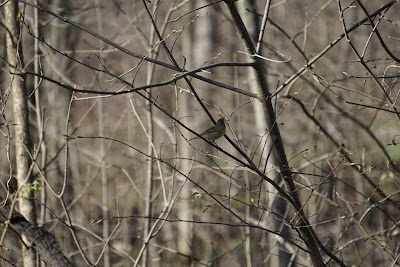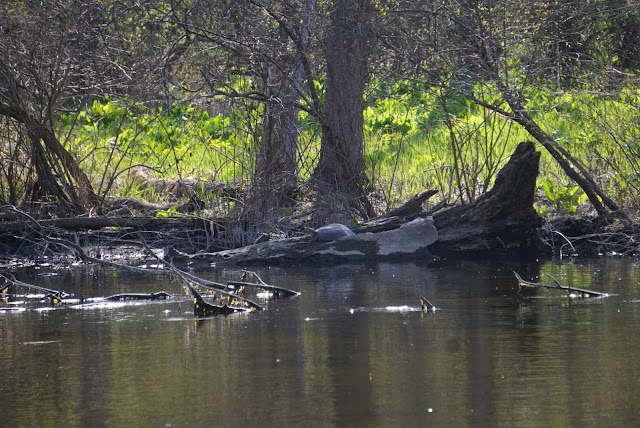Seeing the Swamp
The river was sandy, perfect for Eastern Spiny Softshell Turtles, well that’s what I had read at least; I had yet to see one. This was the herp I wanted to see most this summer and I had little faith that I would in fact get to see it. I assume most people would be shocked to know a turtle like the softshell occurs in Michigan, it is really unlike any other turtle that we have here. When you think of a turtle, you think of a creature with a hard shell and scaly skin; the Softshell group throws that notion out the window. Instead, they have a low profile, rubber like shell, webbed feet that enable them to swim faster than most fish, and a snorkel like nose; quite exotic seeming for Michigan. A quick scan of the river showed few logs or shoreline and no basking turtles whatsoever. We turned our attention to the trees for birds and continued on down the path.
 |
| A hatchling Eastern Spiny Softshell Turtle (Apalone spinifer spinifera). Photo from Reptiles and Amphibians of the Great Lakes Region by Harding & Mifsud |
Across from a bend in the river we stepped up to the forest edge. The opening of the forest was a wet depression, that no doubt had several inches of water in it a few weeks ago. However, the lack of significant rain recently had left the depression mucky, likely ending the lives of any young amphibians that had started their lives there, hoping for several more weeks of water to get them to their final stages of development. Looking above the muck, the forest began to move. A red-bellied woodpecker came down from a snag it had been hanging out on to scare a small downy woodpecker. Whatever the downy was interested in, the red-bellied wanted it. I watched the red-bellied for some time hopping around the base of a snag that was rotted out at the base, likely holding a buffet of insects. Murphy called my attention to a Hermit Thrush on the ground cautiously flipping leaves and watching us. Then a male Bluebird on a branch just sitting there, seeming to be looking directly at us with curiosity. There was little doubt in my mind that more birds flew around above us in the highest reaches of the trees. It never ceases to amaze me how much can be see in a small area of forest.
 |
| A Red-bellied Woodpecker, a common sight (and sound) in the deciduous forest. These can be drawn to backyard suet feeders as well. |
 |
| Hermit Thrush facing us as it took a break from flipping leaves to make sure we weren’t up to anything. |
The forest has several permanent but shallow ponds dotted throughout it. Last year around this time, I had noted several turtles in these ponds basking on logs. This year though, it didn’t seem like there were as many, something I mentioned aloud as we stopped on the trail to scan the logs in a pond that was a hundred feet off the trail. No sooner had I mentioned it, Murphy pointed out two medium sized snapping turtles basking on the same log in the pond. Due to the size of snapping turtles and their defensive nature, they have few predators once they get to a certain size; something they appear to be aware of and display in the way that they lay out to bask on logs. I would characterize their basking habit as “passed out while drunk.” Their chunky legs fall lazily off to the sides of logs; their tails doing the same. It reminds me of laying on a pool float after several hours of day drinking and being out in the sun. A pair of wood ducks cruised past these two and I wondered if the ducks recognized them as future predators to their young.
 |
| Can you spot the basking Snapping Turtles and the pair of Wood Ducks? |
 |
| A Tufted Titmouse rummaging through leaf litter. |
 |
| Northern Water Snake |
 |
| My lifer Eastern Spiny Softshell Turtle. From farther upstream, we thought this was a piece of trash hung up on the logs. |
 |
| A Map Turtle that was seen on our side of the river. Difficult to tell in this photo, but the yellow patterning on the head and neck along with the notched shell on the rear gave this one away. |
 |
| Palm Warbler spotted on our way back to the car. These birds winter in the Southeast U.S. and the Caribbean and nest mostly in Canada |
This is one of the reasons I decided to start writing, because people just don’t see what is right there in front of them. To that guy the bike path cuts through the forested swamp and next to a river and to him those things are static: they are always there and they are what they are. But by just taking a few minutes you can see that the forest is not static, the forest has spring ephemerals that bring the forest to life every spring, the swamp has lazy Snapping turtles and birds that have migrated thousands of miles to raise their young. The river could have several species of turtles crawling across the bottom of the river, hunting for crayfish, basking on logs, or laying a nest on the sandy shore.
So no, we were not “just looking at the swamp,” we were “seeing the swamp,” and I encourage everyone to try and do the same.
Notes:
While writing this post, I was reminded of a short video called The Wasteland made by someone I follow on Instagram. I find it especially relevant to this post.
Sources:
Much of the information regarding turtle habitat and identification is from Amphibians and Reptiles of the Great Lakes Region by James H. Harding and David A. Mifsud




Comments
Post a Comment